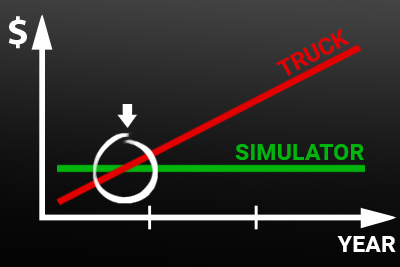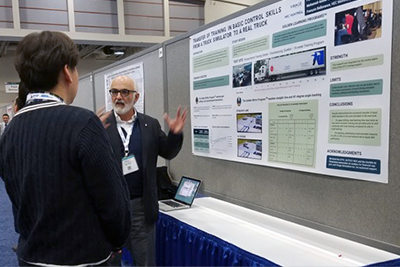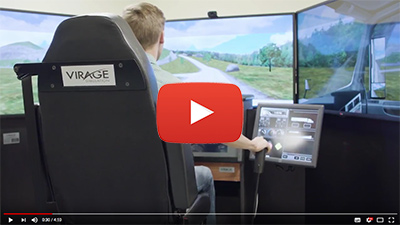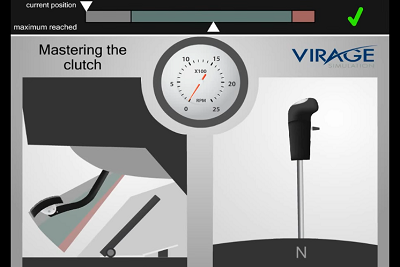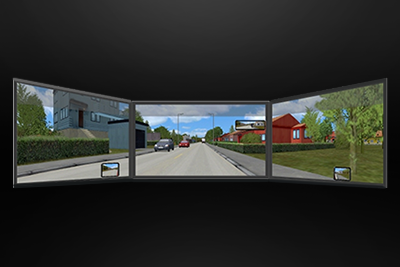Pierro Hirsch PhD
Virage Simulation
July 2015
Introduction
For several decades, operators of motor vehicle fleets have recognized that investments in driver training yield multiple benefits, i.e. reduced costs and improved safety. Traditional driver training consists of diverse blends of classroom theory and invehicle training on closed circuits or in real traffic. Recently, due to the combination of decreasing costs of computer hardware and software and increasing realism of image production, driving simulator-based training has become more attractive and feasible. In addition, the progressive manufacturers of driving simulators are focusing more resources on the development and scientific validation of their courseware, i.e. the learning scenarios available on their products. Before investing in driving simulators, fleet managers should ask a key question: “Compared to traditional driver training methods, is driving simulator-based training equally or more efficient?” A scientific answer to this question must be based on logic and evidence. The first section of this three-part paper reviews the fundamental logic underlying simulator training and outlines eight reasons why it can be more efficient for fleets than traditional driver training. The second section presents research evidence for the benefits of simulator training in terms of training efficiency, cost-effectiveness and financial savings.
The final section recommends best practices for utilizing and optimizing simulator technology within a driver-training program. The multiple advantages of driving simulators for training drivers Eight logical reasons are listed below for why driving simulator-based training is more efficient than traditional driver training:
1. Increased cost-savings and safety
Learner drivers, by definition, lack knowledge, skill and experience. Most learner drivers are also young males who may lack the maturity needed to consistently make safe driving decisions. Driving simulators allow learners to experience the consequences of their actions in an almost unlimited range of driving situations without risk of material damage and injury. Equivalent training in the real world would be prohibitively expensive and dangerous. A well-designed and administered driving simulator-based training program can improve vehicle control, traffic management, hazard perception and decision making without building dangerous overconfidence.
2. Training for critical and rare driving events
Even experienced drivers have relatively little exposure to critical events, e.g. tire blowouts, animals or pedestrians crossing the road. Simulator training allows learners to practice and to develop greater competence in a wider variety of situations in a shorter period of time than would be possible using traditional driver training. Simulators also facilitate recurrent training in critical situations, e.g. every six months commercial pilots rehearse the correct responses to critical events in flight simulators.
3. Learning scenario programmability and versatility
The most obvious advantage of programmable, interactive driving simulators is to allow learners to be exposed, trained and tested in different combinations of weather, road or traffic environments. A less obvious but arguably even greater advantage is that programmable driving simulators allow the designers and managers of training curricula to:
a) Analyze complex driving tasks, maneuvers or traffic situations and segment them into simpler, part-task training exercises that are easier to learn and which can later be combined into whole-task exercises;
b) Modify and improve the efficiency of simulator-based training scenarios according to feedback from learners, trainers and fleet managers;
c) Program new scenarios to meet novel and evolving challenges, e.g. new technologies in vehicles, new traffic controls and new road configurations, and;
d) Reconstruct actual crash scenarios for purposes of review and continuing education for fleet drivers.
4. Standardization of training programs
Driving simulators can deliver standardized programs that are completely independent of the location of the training site and the availability of the specific combinations of road, weather and traffic conditions required to achieve learning objectives. Simulator training makes it possible for each driver in a fleet to receive a standardized training program at any time of day or year and at any location, i.e. mobile driving simulators can service fleet drivers across a large territory without displacing drivers.
5. Increased ability to apply proven pedagogical principles
Simulator training allows learners to progress from simple to complex tasks at their own pace. Self-paced learning reduces frustration and facilitates greater comprehension, retention and transfer of skills to the real world. Compared to traditional driver training, simulator training efficiently delivers a higher quantity and quality of training events in a given time period - this allows learners to repeat the lessons they need to become competent drivers. Repeated actions become habitual or automatic. Automatic actions, also known as “muscle memory”, are performed smoothly and quickly with little or no conscious thought, reducing the driver’s mental workload and increasing his ability to anticipate and avoid traffic conflicts. In addition, driving simulators with an open-cockpit design facilitate the application of proven pedagogical principles like demonstrations, group lessons, and peer teaching, all of which have been under-utilized in the past due to the built-in limitations of traditional in-vehicle driver training.
6. Enhanced control of the learning process
Simulator training allows fleet managers, trainers and learners to exercise more control over the learning process. Driving simulators with good courseware and record keeping allow fleet managers to monitor the progress of each learner and group of learners, direct training at low-performing drivers and transition the fleet to a competency-based standard of driver performance. Trainers using driving simulators have more freedom to prescribe the type, timing and frequency of driving lessons and to adapt the training to each student’s capabilities. Programmed learning scenarios with automatic, objective scoring allow learners to progress at their own pace with or without trainer supervision. Simulator training also facilitates recurrent training for important skills that reduce operational costs, such as eco-driving, and driving maneuvers that are rarely practiced under normal driving conditions, such as correct and timely responses to emergencies.
Over time, drivers naturally forget the initial training that is not positively re-enforced on a regular basis. As a result, they may develop less than optimal driving habits. With simulator training, important driving skills can be reviewed at regular intervals in order to maintain high standards of driver behavior.
7. Higher quality feedback
Compared with traditional driver training, simulator training can provide several forms of higher quality feedback. Within the training scenario, augmented cuing in the form of images, symbols, sounds and imbedded video clips can provide the learner with novel and creative feedback (e.g. a kinetic energy meter, different camera angles for playback). This timely and mostly non-verbal feedback can accelerate learning by reducing barriers related to individual differences in educational backgrounds, language and culture. Simulator training also allows for objective and reliable driver performance scores that can be displayed to the learner during or after each scenario and which can be compared to average group scores. The record and playback feature combined with alternative camera angles allows the learner and the trainer to replay the scenario and discuss the decisions and actions taken by the learner. Learners, or groups of learners, can review and reflect on each driver performance and, where applicable, discuss alternatives. Learners can then repeat the exercise making the necessary corrections. This iterative process changes the neural circuits in the learner’s brain so that when they confront similar situations in real life the probability is higher that the correct actions will be triggered.
8. Improved train-the-trainer programs
\Frequently, the trainers of new drivers of commercial vehicles are former commercial drivers with a wealth of driving experience, independent spirits and little or no formal training as teachers working in a team. Driving simulators with standardized scenarios and objective scoring facilitate group train-the-trainer sessions during which trainers can discuss the learning objectives determined by the fleet manager, learner performance criteria and best-practice teaching methods. This form of driving simulator-based group training for teachers can improve overall teaching standards and help individual trainers calibrate their own teaching styles to those of the group. Greater agreement among trainers can improve learning for individuals who are exposed to more than one trainer and clarify the expectations of the fleet manager.
Scientific evidence of safety benefits
Designing and executing a scientific evaluation of the long-term safety benefits of driving simulator-based training is a complex and expensive project that can require several years to complete. Not surprisingly, few studies have been undertaken. However, objective evidence of the short-term effectiveness of simulator training has appeared in scientific journals, conference papers, published reports and doctoral theses. Additional subjective evidence is provided by reports from actual users of driving simulators in fleets. The following is a list of multiple and concurrent benefits of simulator training and supporting references.
1) Simulator training reduces fleet costs related to fuel consumption, vehicle maintenance and repairs
Given the rising costs of fuel, eco-drive training is receiving an increasing amount of attention. A fleet in Europe (IRU, 2003) conducted an eco-drive training program that included simulator training for all drivers and recurrent training for the worst drivers. The fleet management’s goal was a modest annual 2% reduction in fuel costs over the study period (1995-2000). The program resulted in an annual average reduction of 2.64%. In the year 2000, the fleet manager reported saving 74,225 litres in fuel with a cost savings of EUR 76,000. A large-scale project in Quebec found that drivers trained in eco-driving techniques with a specially programmed Virage Simulation driving simulator achieved real-world fuel reductions one month after training of 9.5% on the highway and 11% in the city (Eco-driving, 2011). Reed et al. (2007) conducted a study comparing driver performance pre- and post-simulator training and found reductions in fuel consumption of 11.4%. In addition, travel time over the same route was reduced by 10.6% and gear changes were reduced by 20.8%.
Better anticipation of traffic is a key lesson of eco-drive training and is associated with fewer gear changes and reduced usage of clutch and brakes. This change in driving style could translate to lower costs for vehicle maintenance and repair. Currently, Dr. Andrew Jardine, a leading expert in fleet vehicle maintenance, reliability and life cycle optimization from the University of Toronto, is planning to study the effects of eco-drive training on fleet operation costs using the Virage Simulation ecodrive training program.
2) Simulator training reduces fleet costs related to crashes
One study found that professional drivers who received simulator training had 22% fewer crashes compared to a control group who only practiced with real cars (Heinrich and Wieland, 1997). Haworth and Symmons (2001) report on two studies that found that ecodrive training resulted in crash rate reductions of 35%. A reduction in the number of crashes in a fleet could create direct and indirect benefits such as: lower insurance premiums; lower driver injuries and consequent sickness absence; reduced fleet management costs, and; reduced risk of liability claims and related legal costs.
Simulator training also facilitates the documentation of individual driver training hours, scenarios and scores; these objective records can be used in court cases to demonstrate due diligence by the fleet manager and absolve the organization of responsibility for crashes that may occur.
3) Simulator training reduces training costs
There is substantial evidence that lessons learned on a driving simulator transfer to real world driving performance (Morgan, et al. 2011; Strayer et al. 2003; Strayer et al. 2005; Uhr et al. 2003). Lindsey and Barron (2008) found that emergency vehicle drivers trained on a driving simulator, compared to drivers who received only in-vehicle training, took significantly less time to drive through the competency course, acquired significantly fewer penalty points and required significantly fewer runs to complete the course. Given the substantial difference in operational costs per hour between a simulator and a heavy vehicle, transferring on-road training to the simulator will result in considerable cost savings. Morgan et al. (2011) compared truck-driver training on simulators and in trucks and concluded that correctly structured simulator training “could result in cost savings for an organization.”
Further, there is growing evidence that when experts in simulation and training collaborate to develop dedicated courseware, simulator training becomes at least twice as efficient as training in real vehicles. The HEC Montreal, a leading research university, in collaboration with the Centre de Formation en Transport de Charlesbourg, a professional truck driver training school in Quebec that graduates 1,000 students annually, conducted a series of transfer-of-training evaluations of the Virage Simulation Golden© self-paced learning courseware for truck simulators. The researchers found that novice truck drivers who completed the simulator-based Golden Shifter© program prior to their in-truck training attained the same level of gear-shifting competence in less than half the time, i.e. a transfer-efficiency ratio 1 : 2.4, meaning that one hour of selfpaced truck simulator training equaled 2.4 hours of in-truck, instructor-led training (Hirsch et al., 2011). In a follow up study, only the duration of time training on the simulator was measured and results showed that one hour on the simulator equaled two hours in the truck, i.e. transfer-efficiency ratio of 1 : 2 (Hirsch and Bellavance, 2013).
4) Simulator training improves training quality
Goode et al. (2013) reviewed the scientific literature and report evidence from several studies indicating that drivers who were trained on driving simulators were more likely to perceive and respond appropriately to hazards in a driving simulation and had better objective scores for driving performance, including braking patterns, speed control and eye movement measures – in addition, these training effects were still evident several weeks after training.
5) Driving simulators increase the ability to detect, screen and retain safer drivers in afleet
There is growing evidence from evaluation studies looking at diverse groups of drivers that a simulator-based driver evaluation can predict on-road performance (Bédard et al. 2010; De Winter et al. 2009; Lee et al., 2003a, 2003b; Lew et al. 2005; Shechtman et al. 2009). Virage Simulation has developed a simulator-based Multidimensional Driver Assessment (MDA) © which shows promise as a normative tool for assessing the safety of fleet drivers at the pre-hire stage and during initial and recurrent training. Studies to validate the MDA against real life crash risk are in progress. 6) Simulator training receives high approval scores from users Effective practices to reduce bus accidents were assessed by the US Federal government (TCRP, 2001).
At that time, the use of a driving training simulator was not widespread throughout the industry (only 16 percent of all systems used simulators). However, 75 percent of the users of high-fidelity simulators rated simulator training as highly effective. Kihl and Wolf (2007) assessed a simulator-based snowplow driver training in Arizona and reported that Department of Transport administrators were “optimistic about the potential for driving simulators to become an integral part of a comprehensive driver-training program”. Reep et al. (2013) investigated three Florida public transit agencies and several transit agencies outside Florida that had incorporated and integrated simulator training into their existing bus operator training programs. The researchers report that study participants are “unwavering in their confidence in the value of simulator training” and that transit agencies “regard simulators as an innovative, interactive method of training that enables them to provide theory-based approaches to the challenges of operating a bus, by offering strategic demonstration and practice-based methods instruction”. Preliminary feedback from a transfer of training study with novice drivers indicates that driving school students who replaced one to seven hours of their 15 hours of mandatory on-road driving lessons with driving simulator lessons considered that learning on the simulator was more or equally efficient to on-road lessons for every one of 15 specified driving skills, including vision training, understanding mirrors and blind spots and hazard perception (Bellavance and Hirsch, 2013).
Best practices for optimizing the benefits of simulator training
How much training can be done on the driving simulator versus in the vehicle? One study comparing drivers trained only in trucks with drivers who took 60% of their training in truck simulators found that both groups of drivers achieved equal competence (Morgan et al., 2011). For specific driving skills or with specific, dedicated courseware, it is conceivable that even greater proportions of driver training can be effectively achieved on driving simulators. However, it will always be important to alternate some training on real vehicles with simulator training in order to validate and reinforce lessons learned on the simulator. At present, it is advisable to regard driving simulators and training courseware as sophisticated tools that enhance the learning process and enable trainers to become more effective and efficient. Simulation-based tools are most effective when they are well integrated into the overall driver-training program.
The following interrelated points are the recommended best practices for integrating simulator training into fleet driver training:
1) Identify training needs as precisely as possible and specify the performance and evaluation criteria for desired competency levels
2) Analyze which media, i.e. classroom theory, driving simulators, in-vehicle training, is best suited for addressing each of the identified training needs
3) Design simulator scenarios to meet training goals (Simulator courseware should be based on a thorough comprehension of the training objectives and can be as important as, or even more than, hardware and software specifications)
4) Consider learner characteristics (e.g. demographics, prior knowledge and experience, motivation) when designing simulator scenarios
5) Develop appropriate short- and long-term performance measurements and feedback - Consult with experts in simulation-based driver training and consider the characteristics of the work environment (i.e. the type of reinforcement available post-training)
6) Support trainers with instruction on the optimal use of the driving simulator and courseware and monitor their performance (e.g. provide trainers with feedback and incentives)
When all the above steps are implemented during the integration of simulator training into fleet driver training, the potential to achieve excellent training results should increase greatly (see discussion in Romoser and Hirsch, 2011).
Conclusion
This article presents eight logical and six research-based reasons to introduce simulator training into fleet driver training. Fleet managers who invest in simulator training may receive additional benefits from the enhanced positive image and greater public prestige given to organizations that demonstrate a tangible commitment to greater environmental responsibility, e.g. with eco-drive training and zero fuel consumption during driver training. In addition, simulator training may also help a fleet comply with mandatory health and safety requirements.
Given the historic and non-controversial acceptance of simulator-based training by the military, the aviation industry and the medical profession as well as the increasing quality of affordable driving simulator hardware and software, there is a high probability that an increasing percentage of future driver training and evaluation for fleet drivers will be done on driving simulators. The logic and the evidence support the adoption of the simulator training. Moreover, the benefits of simulator training can be greatly enhanced if sufficient attention is paid to all aspects of the integration of driving simulators into driver-training programs, especially the quality of courseware. Research cited in this article indicates that well-planned improvements in driving simulator courseware are able to cut learning time in half.
References:
Bellavance, F. & Hirsch, P. (2013).
Novice Learner Driver Perceptions of the Efficiency of Driving Simulator-Based Training in Quebec. Proceedings of the 23rd Canadian Multidisciplinary Road Safety Conference. Montreal, Quebec, May 26-29, 2013.
Bédard, M.B., Parkkari, M., Weaver, B., Riendeau, J., & Dahlquist, M. (2010).
Assessment of driving performance using a simulator protocol: Validity and reproducibility. The American Journal of Occupational Therapy 64, 336-340.
De Winter, J. C. F., De Groot, S., Mulder, M., Wieringa, P. A., Dankelman, J., & Mulder, J. A. (2009).
Relationships between driving simulator performance and driving test results. Ergonomics 52, 137-153.
Eco-Driving (2011). http://www.ecomobile.gouv.qc.ca/en/proven_savings_potential.php
Haworth, N., & Symmons, M., (2001). The Relationship between Fuel Economy and Safety Outcomes. Monash University Accident Research Centre, Victoria, Australia
(Report No 188; pp. 1-67).
Hirsch, P. & Bellavance, F. (2013). [Transfer-of-Training Efficiency Study]. Unpublished raw data.
Hirsch, P., Bellavance, F. & Pignatelli, S. (2011). An Evaluation of the Effectiveness of Simulator-Based Training on the Acquisition of Gear-Shifting Skills for Learner Truck Drivers. Proceedings of the 21st Canadian Multidisciplinary Road Safety Conference, May 8-11, 2011. Halifax, Nova Scotia.
Lee, H-C., Lee, A. H., Cameron, D., & Li-Tsang, C. (2003). Using a driving simulator to identify older drivers at inflated risk of motor vehicle crashes. Journal of Safety Research 34, 453-459.
Lee, H-C., Cameron, D., & Lee, A. H. (2003). Assessing the driving performance of older adult drivers: on-road versus simulated driving. Accident Analysis and Prevention 35, 793-803.
Lew, H. L., Poole, J. H., Lee, E. H., Jaffe, D. L., Huang, H-C. & Brodd, E. (2005).
Predictive validity of driving- simulator assessments following traumatic brain injury: A preliminary study. Brain Injury. 19, 177-188.
Lindsey, J. T. & Barron, A. E. (2008). Effects of simulation on emergency vehicle drivers’ competency in training. Prehospital Disaster Medecine. 23(4) 361–368.
Morgan, J. F., S. Tidwell, et al. (2011). "On the training and testing of entry-level commercial motor vehicle drivers." Accident, Analysis and Prevention. 43(4): 1400-1407.
Reed, N., Cynk, S., & Parkes, A.M. (2010). From research to commercial fuel efficiency training for truck drivers using TruckSim. In Dorn, L. (Ed.), Driver Behaviour and Training, Volume IV (pp. 257-268). Aldershot, UK: Ashgate
Reed, N., Parkes, A.M., Peacock, C., Lang, B., & Rehm, L. (2007). SCOTSIM: an evaluation of the effectiveness of two truck simulators for professional driver training (Report No. PPR214). Transport Research Laboratory, Crowthorne, UK.
Robin, J.L., Knipling, R.R., Tidwell, S.A., MacFann, J., Derrickson, M.L. & Antonik, C. (2005) Truck Simulator validation (“SimVal”) training effectiveness study. Proceedings of the 2005 Truck & Bus Safety & Security Symposium. Alexandria, VA., November 14-16, 2005.
Romoser, M. & Hirsch, P. (2012). From lab to real life: A case study in the deployment of advanced driving simulator-based training systems. Proceedings of the Human Factors and Ergonomics Society Annual Meeting 56(1) 2527-2531.
Shechtman, O., Classen, S., Awadzi, K., & Mann, W. (2009). Comparison of driving errors between on-the-road and simulated driving assessment: A validation study. Traffic Injury Prevention. 10, 379-385.
Strayer, D. L., & Drews, F. A. (2003). Simulator training improves driver efficiency: Transfer from the simulator to the real world. Proceedings of the second international driving symposium on human factors in driver assessment, training and vehicle design, Park City, UT, 190-193.
Strayer, D. L., Drews, F. A., & Burns, S. (2005). The development and evaluation of a high-fidelity simulator-training program for snowplow operators. Proceedings of the third international driving symposium on human factors in driver assessment, training and vehicle design, Rockport, ME, 464-470.
Uhr, M. B. F., Felix, D., Williams, B. J., & Krueger, H. (2003). Transfer of training in an advanced driving simulator: Comparison between real world environment and simulation in a manoeuvring driving task. In Proceedings of the driving simulation conference North America, Dearborn, MI.

